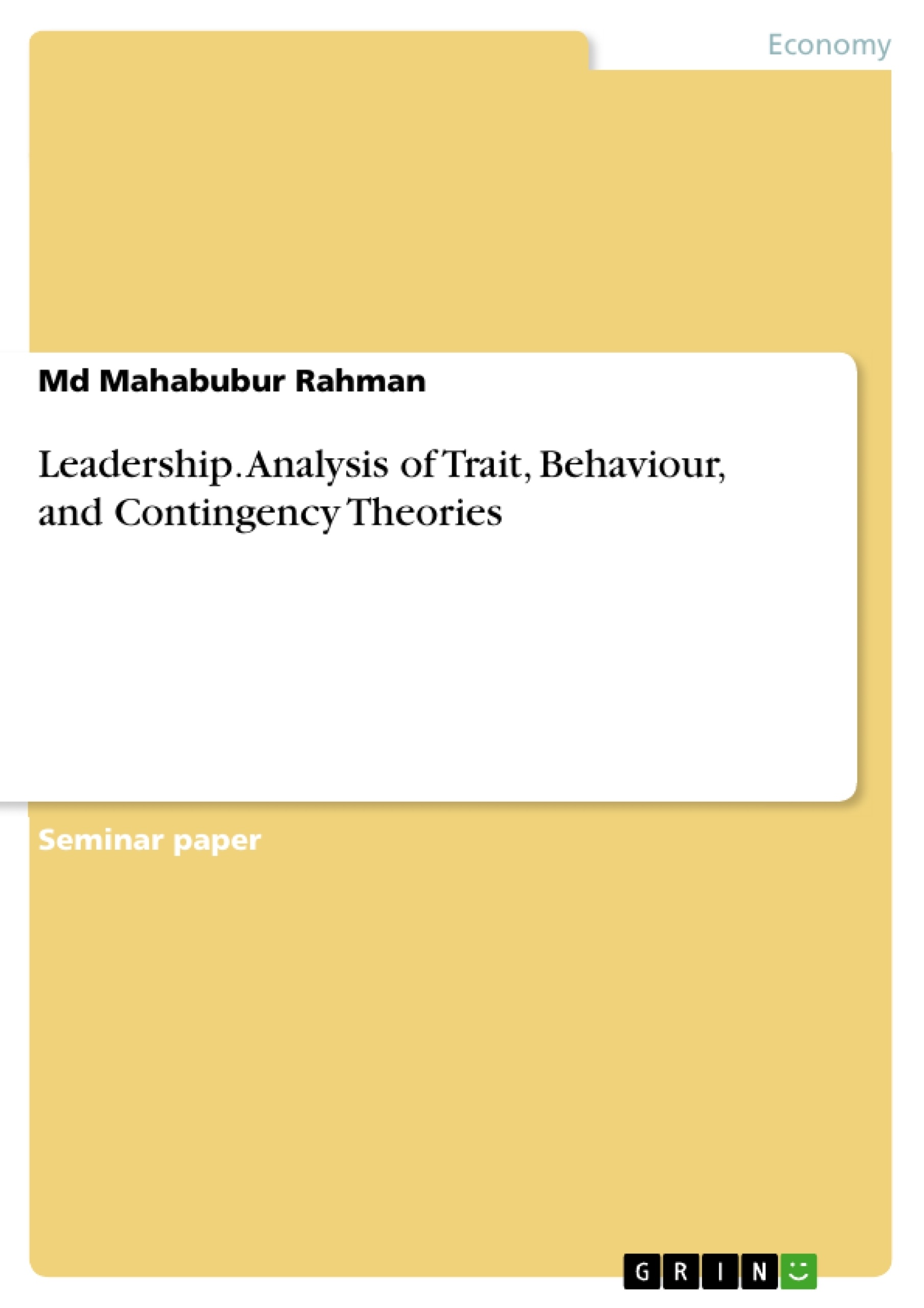There is no doubt of leaders’ existence and profound contribution in developing human civilization. History is littered with stories of many great leaders. Some are recognized for their dexterity in the battlefields, some perhaps for their business acumen or for inspiration for their employees.
Whatever the reasons for fame, humans have recognized that the capability of an individual to make others take action and achieve goals makes them stand out in society. However, the question still remains - what is it that makes them different?
Hence the purpose of this theoretical paper is to provide a review of the definition of leadership and of the three main theories of leadership, namely Trait, Behaviour, and Contingency Theory. The author then chooses a particular focus on Contingency Theory, which is analysed further.
Inhaltsverzeichnis (Table of Contents)
- Abstract
- What is Leadership?
- Leadership theories:
- Trait theory
- Behaviour Theory:
- Contingency or situational Theory:
- The Contingency or Situational Theory.....
- Rationale of choice:
- Path-Goal model:
- Path-goal model approach:
- Application of Path-goal model: …………….………………....
- Methodology:
- Criticisms:
- Conclusion:
- References
Zielsetzung und Themenschwerpunkte (Objectives and Key Themes)
This theoretical paper aims to provide a comprehensive overview of leadership, exploring its definition and analyzing three primary leadership theories. It focuses particularly on the Path-Goal model, critically examining its application and methodology.
- Definition of Leadership
- Theories of Leadership (Trait, Behavior, Contingency)
- The Path-Goal Model
- Application and Methodology of the Path-Goal Model
- Criticisms of Leadership Theories
Zusammenfassung der Kapitel (Chapter Summaries)
- Abstract: This section introduces the paper's objective, focusing on providing a review of leadership definitions and theories, with a particular emphasis on critical analysis of the Path-Goal leadership model.
- What is Leadership?: This chapter explores various definitions of leadership, highlighting the differences between leadership and management and exploring different perspectives on leadership styles, characteristics, and influence.
- Leadership theories: This section outlines the three main leadership theories: Trait theory, Behavior theory, and Contingency theory. It discusses the historical development and key assumptions of each theory.
- Trait theory: This chapter explores the origins of Trait theory, which posits that leaders are born with inherent characteristics that influence their ability to lead. It discusses the historical and contemporary perspectives on this theory.
- Behaviour Theory: This section examines the Behavior theory of leadership, which focuses on observable behaviors and actions of leaders rather than innate traits. It discusses the different leadership styles and their impact on followers.
- Contingency or situational Theory: This chapter introduces the Contingency theory, which emphasizes the importance of situational factors in leadership effectiveness. It delves into the concept of different situations requiring different leadership styles and approaches.
- The Contingency or Situational Theory.....: This section provides a detailed overview of the Contingency theory, exploring its key principles and how it applies to various leadership contexts.
- Rationale of choice: This chapter explains the rationale behind choosing the Path-Goal model for further analysis, outlining its potential strengths and relevance to contemporary leadership challenges.
- Path-Goal model: This section introduces the Path-Goal model, a specific leadership approach that emphasizes the leader's role in clarifying paths for followers and providing support to help them achieve their goals.
- Path-goal model approach: This chapter discusses the principles and methodology of the Path-Goal model, explaining how it helps leaders motivate and guide their followers toward desired outcomes.
- Application of Path-goal model: …………….………………....: This section explores the practical application of the Path-Goal model in various organizational settings and contexts. It examines real-world examples and case studies.
- Methodology: This chapter outlines the research methodology used in the paper to critically analyze the Path-Goal model. It discusses the methods used to gather and analyze data.
- Criticisms: This section examines the criticisms and limitations of the Path-Goal model, highlighting potential weaknesses and areas for further research.
Schlüsselwörter (Keywords)
Leadership, leadership theories, trait theory, behavior theory, contingency theory, path-goal model, leadership styles, organizational behavior, motivation, goal achievement, influence, effectiveness, critical analysis, methodology.
- Quote paper
- Md Mahabubur Rahman (Author), 2016, Leadership. Analysis of Trait, Behaviour, and Contingency Theories, Munich, GRIN Verlag, https://www.grin.com/document/345075




